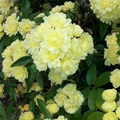Rosa banksiae
| Rosa banksiae | |
|---|---|

| |
| Scientific classification | |
| Kingdom: | Plantae |
| Clade: | Tracheophytes |
| Clade: | Angiosperms |
| Clade: | Eudicots |
| Clade: | Rosids |
| Order: | Rosales |
| Family: | Rosaceae |
| Genus: | Rosa |
| Species: | R. banksiae
|
| Binomial name | |
| Rosa banksiae | |
| Synonyms[2] | |
| |
Rosa banksiae,
Description

It is a scrambling
The flowers are small, 1.5–2.5 cm diameter, white or pale yellow and are fragrant. It is amongst the earliest flowering of all roses, usually appearing during May in the northern hemisphere, though cold weather can delay flowering.[4] All Lady Banks' roses are said to smell of violets to varying degrees.[5]
Taxonomy
"R. banksiae" was first described and published by W. T. Aiton in 'Hortus kew.' edition 2, Vol.3 on page 258 in 1811.[6] Some places attribute Robert Brown as the author [2] but it was agreed in 2018 by ICN that W. T. Aiton was the true author.[6]
Cultivation and uses
Lady Banks Rose (Rosa Banksiae) - The leaves of this plant are said to possess qualities useful in the treatment of wounds and the promotion of tissue formation. The plant is also rich in tannins which are used medicinally as astringents.
Rosa banksiae has likely been grown in the gardens of China for hundreds of years. The species was introduced to Europe by
A number of other forms were subsequently discovered growing in China, including R. banksiae var. normalis (see above), and R. banksiae 'Lutea', the yellow Lady Banks' rose (brought to Europe in 1824 by J. D. Parks). In 1993 this
An R. banksiae planted in Tombstone, Arizona in 1885 is reputedly the world's largest rose bush. It covers up to 9,000 square feet (840 m2) of the roof on an inn, and has a 12-foot (3.7 m) circumference trunk.[10]
Varieties
There are two
- R. banksiae var. banksiae – flowers semi-double or double, with numerous petals replacing most or all of the stamens; a cultigen developed in Chinese gardens
- R. banksiae var. normalis – flowers single, with five petals; the natural wild form of the species
Gallery
-
Lady Banks' Rose in full bloom. Henderson, Nevada, USA
-
Banksia rose, by J. A. Palmer
-
Buds in early spring
-
Rosa banksiae var. "Banksiae"
-
Rosa banksiae var. "Normalis"
-
Flower closeup
-
Rosa banksiae var. 'lutea' in the Rose Garden of theRoyal Botanical Garden of Madrid
-
Trailing towards a window
-
Bushy setting
References
- ^ "Rosa banksiae". Tropicos. Retrieved 2016-11-27.
- ^ a b "Rosa banksiae R.Br. — The Plant List". www.theplantlist.org. Retrieved 17 May 2020.
- ^ a b "Rosa banksiae". Flora of China. Missouri Botanical Garden & Harvard University Herbaria. eFloras. Retrieved 2016-11-27.
- ISBN 978-1405332965.
- ISBN 2-7066-0139-6), p. 185.
- ^ a b "Taxonomy - GRIN-Global Web v 1.10.6.2". npgsweb.ars-grin.gov. Retrieved 17 May 2020.
- ^ Graham Murphy Old Roses (2003)&pg=PA26 Rosa banksiae, p. 26, at Google Books
- ^ "RHS AGM Listing February 2013 Final (Ornamentals)". Royal Horticultural Society. p. 67. Retrieved 2016-11-27.
- ^ "It is a kind of to be used to treat liniment of painful swelling of joints and preparation method thereof". 15 July 2017. Retrieved 24 May 2020.
- ^ Ted Robbins (April 16, 2014). "'World's Largest Rosebush' Graces Arizona Desert Town". Morning Edition. NPR. Retrieved 2016-11-27.
Other sources
- Climbing Roses of the World by Charles Quest-Ritson
- The Graham Stuart Thomas Rose Book by Graham Stuart Thomas









